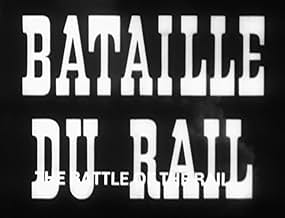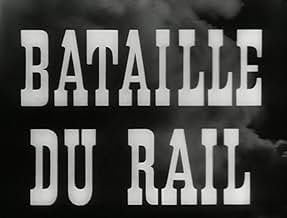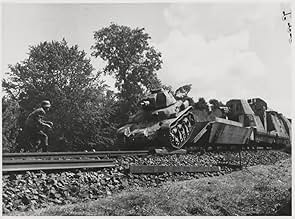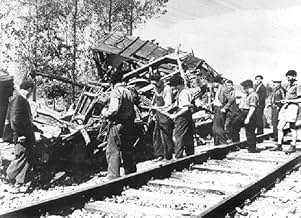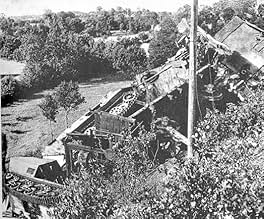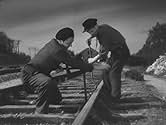Bataille du rail
- 1946
- 1 घं 25 मि
IMDb रेटिंग
7.0/10
1.4 हज़ार
आपकी रेटिंग
अपनी भाषा में प्लॉट जोड़ेंRecounts the courageous efforts by French railroad workers who were part of an organized resistance during German World War II occupation.Recounts the courageous efforts by French railroad workers who were part of an organized resistance during German World War II occupation.Recounts the courageous efforts by French railroad workers who were part of an organized resistance during German World War II occupation.
- पुरस्कार
- 3 जीत और कुल 1 नामांकन
Marcel Barnault
- Cheminot
- (as Barnault)
Jean Clarieux
- Lampin
- (as Clarieux)
Jean Daurand
- Cheminot
- (as Daurand)
Lucien Desagneaux
- Athos
- (as Desagneaux)
François Joux
- Cheminot
- (as Joux)
Pierre Latour
- Cheminot
- (as Latour)
Robert Le Ray
- Chef de gare
- (as Leray)
Pierre Lozach
- Cheminot
- (as Lozach)
Pierre Mindaist
- Cheminot
- (as Mindaist)
Léon Pauléon
- Chef de gare St-André
- (as Pauleon)
Fernand Rauzéna
- Cheminot
- (as Rauzena)
Michel Salina
- Allemand
- (as Salina)
Charles Boyer
- Narrator
- (वॉइस)
- (बिना क्रेडिट के)
फ़ीचर्ड समीक्षाएं
I usually stop watching films when I discover that it has subtitles but I'm glad that I didn't with this one. Stopping German supplies and reinforcements reaching Normandy contributed greatly to the advancement of the Allies, many trains, and rail tracks, were destroyed by the RAF in the run up to the invasion but the events in this film also helped greatly.
After the war the French were very keen to show that they didn't just capitulate ASAP but had an active resistance movement but in the many WWII history books I've read their overall contribution to the victory In Europe is considered to be minimal.
Regardless of that this film is very well worth watching.
After the war the French were very keen to show that they didn't just capitulate ASAP but had an active resistance movement but in the many WWII history books I've read their overall contribution to the victory In Europe is considered to be minimal.
Regardless of that this film is very well worth watching.
Few films in the war genre so acutely bear the imprint of their historical moment as this one, released in 1946, on the immediate heels of the Second World War. Shot in a France still clearing rubble and reconciling its deep scars, the film operates not simply as cinema but as testimonial-lean, austere, and fiercely intentional in both style and spirit. The choice to blur the line between fiction and documentary, with many non-professional actors and real railway workers playing themselves, gives it a tactile authenticity that stands in stark contrast to the more theatrical or mythologizing approach of contemporary Allied productions. This hybrid aesthetic-docudrama before the term had even properly crystallized-grounds the film in a truth that was still palpably raw for its original audience, one that was not yet ready to sentimentalize the Resistance.
The cinematography is stark and functional rather than expressive, a reflection of both budgetary constraints and a deeper ideological commitment to realism. The camera lingers on machinery, process, and labor-not only to build suspense but to valorize the technical and human precision that went into acts of sabotage. There is a visual grammar of resistance, conveyed through tracking shots along rails, the choreography of hands on levers, and the rhythm of trains cutting through the French landscape. These sequences echo the industrial poetry found in Fires Were Started (1943), though here the stakes are higher and the violence more sudden. Unlike that British wartime docudrama, however, this film refrains from idealizing its protagonists; their courage is neither clean nor abstract-it emerges through action, in the face of brutality, and often ends without glory.
Sound design plays a remarkably understated but powerful role. The mechanical clatter of trains, the hiss of steam, and the ambient hum of resistance are given equal weight to dialogue. Silence is often used with brutal efficiency, especially in the moments leading up to acts of sabotage or during reprisals. The absence of a swelling score or overt musical cues deprives the viewer of catharsis, insisting instead on a more sober engagement with events.
Performance is deliberately muted, almost anti-theatrical. This is not a vehicle for star power but for collective identity. The ensemble approach-coupled with the use of railway workers and resistance fighters portraying versions of themselves-dismantles the usual hierarchy between actor and role. At times, this can lead to a certain stiffness in delivery, but it serves the film's ideological mission: to honor the anonymous and the ordinary, the faceless who shaped history. There is little psychological probing; instead, character is revealed through tasks performed, risks taken, and loyalties tested under pressure. This approach diverges sharply from the character-driven drama of The Train (1964), which, though also concerned with sabotage on the rails, places far greater emphasis on individual cunning and dramatic arc than on the collective ethic foregrounded here.
Shot and produced during France's immediate post-liberation period, the film cannot be extricated from the cultural and political climate of 1945-46. It functions as both a rallying cry and an act of purification-reaffirming a narrative of widespread resistance at a time when national memory was being rapidly reassembled. France had endured a catastrophic and humiliating military defeat in 1940, with the collapse of its army in just six weeks and the swift occupation of its territory. That trauma lingered heavily, not only as a strategic failure but as a perceived existential collapse of the French military establishment. In this context, the film takes on the added function of counterbalance: by highlighting the technical sophistication, precision, and coordination of railway sabotage, it implicitly restores a kind of military competence and honor to the national narrative. The resistance shown here is not portrayed as a spontaneous or amateurish reaction, but rather as a clandestine force with the rigor, discipline, and tactical efficacy that the French army had failed to project during the actual conflict. The trains are both symbol and weapon, and mastering them becomes an act of reclaiming agency. In depicting this underground war with such methodical clarity, the film offers a compensatory image-France not as a passive victim of Blitzkrieg, but as a nation that fought back with calculated resolve and strategic skill, albeit from within.
This is not subtle, nor is it meant to be. The message is delivered with clarity and urgency: the resistance was broad, the people were brave, and France stood against occupation. Yet even as it partakes in myth-making, it does so with a notable sense of gravity and restraint. There is no bombast, no overt patriotic swelling-only the sober gaze of a nation trying to reclaim its dignity through a kind of neorealist liturgy.
The editing follows a rhythm that is closer to reportage than traditional war cinema. Cuts are often abrupt, even jarring, emphasizing the fragmentary and volatile nature of resistance life. This unpolished style, which might be read today as primitive, was at the time a radical break from the smoother, studio-bound productions of prewar cinema. It reflects both a shortage of resources and a defiant embrace of the provisional and the handmade. The decision to maintain a chronological narrative structure, eschewing flashbacks or narrative tricks, serves to mirror the straightforward heroism the film wishes to commemorate.
If it falters, it is perhaps in the moments where the didactic impulse overpowers the dramatic. Certain sequences lean heavily on archetype and moral clarity, flattening complexity in favor of edification. Yet even here, one senses that the urgency of historical rehabilitation-of reclaiming a narrative of resistance amid lingering collaborationist shame-justifies the lack of ambiguity. In this sense, the film is both an artwork and a social instrument, forging consensus as much as crafting cinema.
The film endures less for any technical innovation than for its clarity of purpose and its profound integration of content and form. It does not aim to entertain or even to move in the conventional sense-it demands recognition. And in doing so, it carves out a place not only in the canon of war cinema but in the deeper, more solemn archive of historical memory.
The cinematography is stark and functional rather than expressive, a reflection of both budgetary constraints and a deeper ideological commitment to realism. The camera lingers on machinery, process, and labor-not only to build suspense but to valorize the technical and human precision that went into acts of sabotage. There is a visual grammar of resistance, conveyed through tracking shots along rails, the choreography of hands on levers, and the rhythm of trains cutting through the French landscape. These sequences echo the industrial poetry found in Fires Were Started (1943), though here the stakes are higher and the violence more sudden. Unlike that British wartime docudrama, however, this film refrains from idealizing its protagonists; their courage is neither clean nor abstract-it emerges through action, in the face of brutality, and often ends without glory.
Sound design plays a remarkably understated but powerful role. The mechanical clatter of trains, the hiss of steam, and the ambient hum of resistance are given equal weight to dialogue. Silence is often used with brutal efficiency, especially in the moments leading up to acts of sabotage or during reprisals. The absence of a swelling score or overt musical cues deprives the viewer of catharsis, insisting instead on a more sober engagement with events.
Performance is deliberately muted, almost anti-theatrical. This is not a vehicle for star power but for collective identity. The ensemble approach-coupled with the use of railway workers and resistance fighters portraying versions of themselves-dismantles the usual hierarchy between actor and role. At times, this can lead to a certain stiffness in delivery, but it serves the film's ideological mission: to honor the anonymous and the ordinary, the faceless who shaped history. There is little psychological probing; instead, character is revealed through tasks performed, risks taken, and loyalties tested under pressure. This approach diverges sharply from the character-driven drama of The Train (1964), which, though also concerned with sabotage on the rails, places far greater emphasis on individual cunning and dramatic arc than on the collective ethic foregrounded here.
Shot and produced during France's immediate post-liberation period, the film cannot be extricated from the cultural and political climate of 1945-46. It functions as both a rallying cry and an act of purification-reaffirming a narrative of widespread resistance at a time when national memory was being rapidly reassembled. France had endured a catastrophic and humiliating military defeat in 1940, with the collapse of its army in just six weeks and the swift occupation of its territory. That trauma lingered heavily, not only as a strategic failure but as a perceived existential collapse of the French military establishment. In this context, the film takes on the added function of counterbalance: by highlighting the technical sophistication, precision, and coordination of railway sabotage, it implicitly restores a kind of military competence and honor to the national narrative. The resistance shown here is not portrayed as a spontaneous or amateurish reaction, but rather as a clandestine force with the rigor, discipline, and tactical efficacy that the French army had failed to project during the actual conflict. The trains are both symbol and weapon, and mastering them becomes an act of reclaiming agency. In depicting this underground war with such methodical clarity, the film offers a compensatory image-France not as a passive victim of Blitzkrieg, but as a nation that fought back with calculated resolve and strategic skill, albeit from within.
This is not subtle, nor is it meant to be. The message is delivered with clarity and urgency: the resistance was broad, the people were brave, and France stood against occupation. Yet even as it partakes in myth-making, it does so with a notable sense of gravity and restraint. There is no bombast, no overt patriotic swelling-only the sober gaze of a nation trying to reclaim its dignity through a kind of neorealist liturgy.
The editing follows a rhythm that is closer to reportage than traditional war cinema. Cuts are often abrupt, even jarring, emphasizing the fragmentary and volatile nature of resistance life. This unpolished style, which might be read today as primitive, was at the time a radical break from the smoother, studio-bound productions of prewar cinema. It reflects both a shortage of resources and a defiant embrace of the provisional and the handmade. The decision to maintain a chronological narrative structure, eschewing flashbacks or narrative tricks, serves to mirror the straightforward heroism the film wishes to commemorate.
If it falters, it is perhaps in the moments where the didactic impulse overpowers the dramatic. Certain sequences lean heavily on archetype and moral clarity, flattening complexity in favor of edification. Yet even here, one senses that the urgency of historical rehabilitation-of reclaiming a narrative of resistance amid lingering collaborationist shame-justifies the lack of ambiguity. In this sense, the film is both an artwork and a social instrument, forging consensus as much as crafting cinema.
The film endures less for any technical innovation than for its clarity of purpose and its profound integration of content and form. It does not aim to entertain or even to move in the conventional sense-it demands recognition. And in doing so, it carves out a place not only in the canon of war cinema but in the deeper, more solemn archive of historical memory.
THE BATTLE OF THE RAILS is a rare little title that I managed to catch on Talking Pictures TV here in the UK in the first showing since 1960. It's a black and white drama about the efforts of the French Resistance to sabotage Nazi-controlled trains during WW2. The film is made with a documentary realism in which the action is narrated throughout. The photography is excellent and the pacing is fast. The film abandons typical conceits of characterisation and dialogue in favour of a focus on physical action, such as the sabotaging of tracks and trains and the subsequent derailments that follow. It's surprisingly tense, even thrilling at times.
A hidden gem l just discovered !! Tells it like it was !! Dirty , hard , people died . Very good de-railment scene towards the end !! A real derailment excellently shot !
Based on real life events that occurred between the Normandy Landings and the liberation, La Bataille du Rail was commissioned by the Associations of the Resistance soon after the end of the Second World War. That a war film would be put into production so soon after the end of the war and that it would prove so successful with a public that lived through it suggests a desire to show the extent of the resistance's achievements and the pride of the French.
However, Clément carefully avoids making the film too didactic or sentimental. We can see how the ruthlessness of the occupying forces in rooting out the saboteurs and their anti-Semitism is not overplayed as their portrayal seems appropriate to a modern audience not directly scarred by the events shown. Another way in which he achieves this is through the way the camera stays relatively detached from the action, showing the events almost like a documentary rather than forcing us to identify with any of the characters. It has been said that the cast was made up of unprofessional actors and in some cases real railwaymen. This adds to the realism and creates an effect where no one film star stands out as an obvious "hero", enforcing a message of "ordinary men doing what they had to".
However, Clément carefully avoids making the film too didactic or sentimental. We can see how the ruthlessness of the occupying forces in rooting out the saboteurs and their anti-Semitism is not overplayed as their portrayal seems appropriate to a modern audience not directly scarred by the events shown. Another way in which he achieves this is through the way the camera stays relatively detached from the action, showing the events almost like a documentary rather than forcing us to identify with any of the characters. It has been said that the cast was made up of unprofessional actors and in some cases real railwaymen. This adds to the realism and creates an effect where no one film star stands out as an obvious "hero", enforcing a message of "ordinary men doing what they had to".
क्या आपको पता है
- ट्रिवियाIn part financed by what had been the Resistance as a way of showing international audiences what the French population had been facing under Nazi oppression. The Resistance was also keen to let the world know that they had been actively involved in disrupting the German war machine in France as the international perception at the time was that the French had capitulated and collaborated a little too easily with their Nazi captors.
- गूफ़Railway worker tapping Morse code just repeats letter "V" most of the time with only a few exceptions.
- क्रेज़ी क्रेडिट(in cast) et Les cheminots de France
- कनेक्शनFeatured in Cannes... les 400 coups (1997)
टॉप पसंद
रेटिंग देने के लिए साइन-इन करें और वैयक्तिकृत सुझावों के लिए वॉचलिस्ट करें
- How long is The Battle of the Rails?Alexa द्वारा संचालित
विवरण
- रिलीज़ की तारीख़
- कंट्री ऑफ़ ओरिजिन
- आधिकारिक साइटें
- भाषाएं
- इस रूप में भी जाना जाता है
- The Battle of the Rails
- फ़िल्माने की जगहें
- Gare SNCF, Saint-Brieuc, Côtes-d'Armor, फ़्रांस(first scenes, train station)
- उत्पादन कंपनियां
- IMDbPro पर और कंपनी क्रेडिट देखें
- चलने की अवधि1 घंटा 25 मिनट
- रंग
- ध्वनि मिश्रण
- पक्ष अनुपात
- 1.37 : 1
इस पेज में योगदान दें
किसी बदलाव का सुझाव दें या अनुपलब्ध कॉन्टेंट जोड़ें


